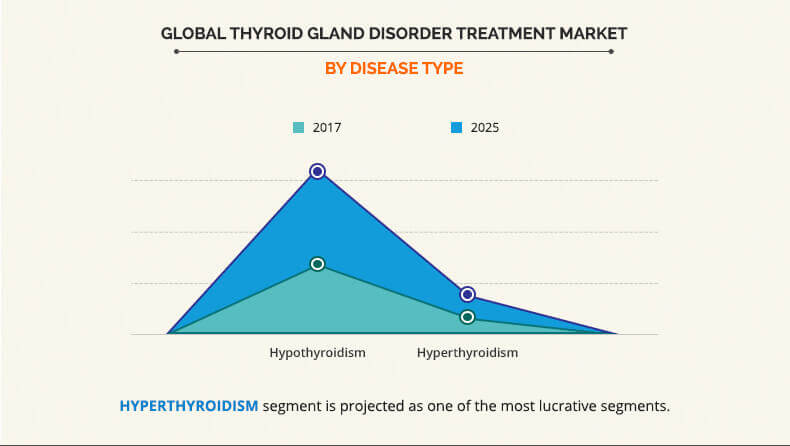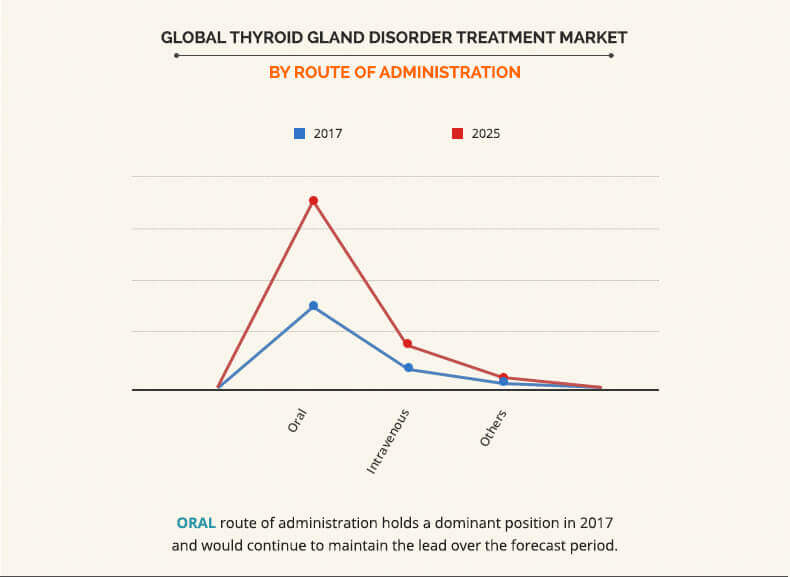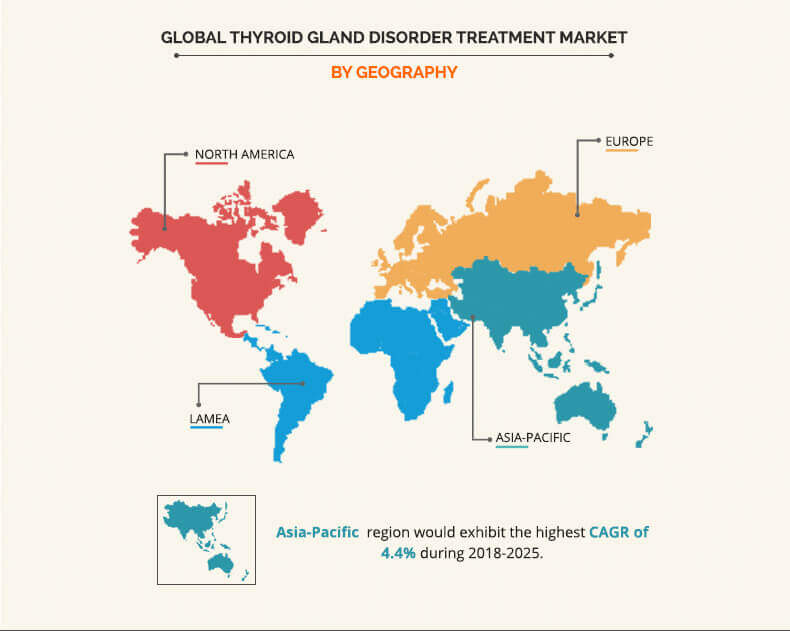Thyroid Gland Disorder Treatment Market Overview:
Thyroid Gland Disorder Treatment Market is an endocrine gland that stimulates hormones, which help regulate the metabolism of the body. When the thyroid gland does not produce enough thyroid hormones (hypothyroidism) or too much hormone (hyperthyroidism), the metabolism and functioning of the body is disrupted. The lack of iodine in the body is a major factor that leads to thyroid disorder. It has been observed that more than 2 billion people are estimated to be at the risk of iodine deficiency worldwide, among which the developing countries have the highest number of undiagnosed patients. The global thyroid gland disorder market was valued at $2,057 million in 2017, and is estimated to reach $2,771 million by 2025 at a CAGR of 3.8% from 2018 to 2025.
The major factors that drive the growth of the market include increase in the incidence of thyroid gland disorder, rise in the number of disease awareness programs especially in the developing countries, and development of effective combination drug therapies to treat thyroid gland disorder. However, side effects of the drugs and stringent government regulations hamper the market growth. Moreover, availability of large pool of undiagnosed patients due to asymptomatic nature of thyroid disorders help open new avenues for the market growth during the forecast period.
Disease type segment review
Based on the disease type, the market is bifurcated into hypothyroidism and hyperthyroidism. The hypothyroidism segment dominates the market, owing to the high prevalence of iodine deficiency population worldwide, and is the most commonly occurring thyroid disorder.
Route of administration segment review
Based on route of administration, the market is classified into oral, intravenous, and others. Oral route of administration is the largest contributor toward the market growth as most of the medications available in the market are in the form of tablets or pills and can be easily administered by patients on daily basis.
Key geographical segment
As per region, the thyroid gland disorder treatment market is analyzed across North America, Europe, Asia-Pacific, and LAMEA. North America accounted for the largest market share in 2017, and is expected to retain its dominance throughout the forecast period.
The key players operating in the global thyroid gland disorder treatment market include AbbVie Inc., Pfizer Inc., Merck & Co., Inc., Lannett Company, Inc., Allergan plc, Mylan N.V., GlaxoSmithKline plc, Novartis AG, RLC LABS, Inc., and Abbott Laboratories.
Other prominent players in the value chain include Takeda Pharmaceutical Company Limited, Aspen, Amgen Inc., Endo International plc, Acella Pharmaceuticals, LLC, and Gemini Laboratories, LLC.
Key Benefits
- This report entails a detailed quantitative analysis of the current market trends from 2017 to 2025 to identify the prevailing opportunities.
- Market estimations are based on comprehensive analysis of the key developments in the industry.
- The global market is comprehensively analyzed with respect to disease type, drug type, route of administration, distribution channels, and region.
- In-depth analysis based on region assists to understand the regional market to assist in strategic business planning.
- The development strategies adopted by key manufacturers are enlisted to understand the competitive scenario of the market.
Thyroid Gland Disorder Treatment Market Report Highlights
| Aspects | Details |
| By DISEASE TYPE |
|
| By DRUG TYPE |
|
| By ROUTE OF ADMINISTRATION |
|
| By DISTRIBUTION CHANNEL |
|
| By GEOGRAPHY |
|
| Key Market Players | Lannett Company, Inc, AbbVie Inc, RLC LABS, Inc, Novartis AG, Merck & Co. Inc, Mylan N.V, Pfizer Inc, GlaxoSmithKline plc, Allergan Plc, Abbott Laboratories |
Analyst Review
Thyroid hormones play an important role in the growth, reproduction, neuronal development, and regulation of energy metabolism. Hypothyroidism and hyperthyroidism caused due to lack or overproduction of thyroid hormone can cause potentially devastating health consequences. Increase in the incidence of thyroid gland disorder and rise in the number of disease awareness programs especially in the developing countries majorly drive the growth of the thyroid gland disorder treatment market.
Patients require medication to either boost the production of thyroid hormones or block the over production of thyroid hormones. Levothyroxine accounts for the largest market share among all these drug types, mainly due to the availability of these drugs in various brand forms. In addition, these drugs can easily be absorbed by the patient and help regulate thyroid hormone.
The use of thyroid gland disorder treatment is highest in North America, particularly in the U.S., owing to highest prevalence rate for thyroid disorders, large number of diagnosed patients as compared to other regions, and favorable reimbursement policies. Although the use of thyroid gland disorder treatment in Asia-Pacific and LAMEA is low, the adoption rate is expected to increase due to the increase in awareness about thyroid conditions and the availability of large number of undiagnosed patients in populace countries such as India and China.
Loading Table Of Content...






